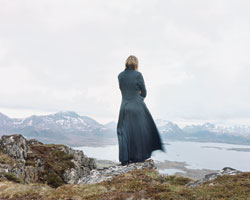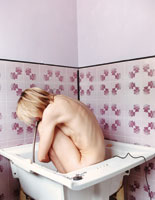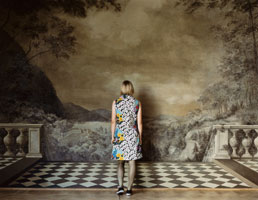3 May - 24 June 2007
The New Painting
Photography
Show opening Wednesday 2 May 2007 starting at 6 pm
Tuesday - Sunday, noon to 6 pm

The show at the Centre pour l'image contemporaine (Center for Contemporary Images) will feature a selection of photographs from The New Painting (2000-2004) series. The title given to this body of work goes back to a passing remark by Edda Jonsdottir (1), which Elina Brotherus happened to catch and took up as a challenge: photography will be the new painting.
This relationship to paintings then determines the iconography and treatment of the themes in The New Painting series. Names and genres surface at varying degrees of clarity, including Caspar David Friedrich, Cézanne, Claude Lorrain, Leonardo's sfumato, the Romantic landscape, the nude, bathers, or even Bonnard or Degas, who spring to mind with certain interiors photographed by Brotherus, such as Femme à sa toilette (Woman Dressing, 2001) or Femme dans la baignoire (Woman in a Bath, 2003).
Brotherus sees photography in terms of representation. She works by series, each of which takes up a theme or issues dealt with in modern painting, which the artist tries out in the field of photography. Her work belongs to a contemporary trend represented by artists like Jeff Wall, who views photography as an extension of questions raised in classic painting.
While Brotherus encourages one to rethink a series of questions that are dear to the pictorial tradition, including composition, light, the inclusion of figures in the landscape, perspective, and so on, at the same time her photographs stress formal qualities in order to return one's eye to the surface and bring out first and foremost a purely visual reading.
There is no contradiction in that dual movement but rather a kind of ricochet. The visual arrangement is presented as an end in itself yet its terms, in a reflection that presided over their assembly, proceed from questions that have guided figurative painters and now reappear in her work in a contemporary way. It is her manner of treating the model that enables Brotherus to introduce this dual gaze.

Reconsidering the model or rather the model's position, Brotherus reworks composition and representation in their entirety. To her the model is an ideal tool for exploration. Approaching it in formal terms, she denies it its potential for narrative, autobiography or autofiction (fictionalized autobiography) which are widely used in contemporary art, while knowing full well that as she places it in the tradition of painting, the model brings its history along with it.
Whereas in her initial series, beyond all aspects of commodity, the artist took herself as her model and introduced a narrative time thanks to that autobiographical dimension, in The New Painting series (in which she continues to make use of herself as model) the autobiographical aspects have disappeared. There her thinking has turned to the formal relationships between the different elements of the composition, especially between the figure and the landscape, subordinating the narrative to the formal components as a whole.
This appears in an exemplary fashion in Nu endormi (Sleeping Nude, 2003), in which the prone nude body in the foreground is transformed into curves which, like a wave, ripple out through the composition's planes and lines. The body's dips, bumps, shadows and hues reverberate like an echo in the receding hills, shaping the landscape.
Freed of its fiction, the figure functions like a measure or instrument for investigating a genre or iconography. Each series offers a reflection or advances a photographic response to a pictorial question.
The group Wanderer 1-5 (which like all the photos of this series shows a figure from behind facing a landscape) explicitly refers to the painting of Caspar David Friedrich, notably Der Wanderer über dem Nebelmeer (The Wanderer above the Sea of Fog, 1818). In Romantic painting, nature assumes mystical and sublime qualities and contrasts with man's finiteness. Brotherus, however, doesn't attribute such properties to her landscapes; they are given spaces, selected for their ability to suggest a pictorial genre and the questions it raises.
Before the immensity of landscapes, her figures present composition with a challenge, and the memory of pictures by C. D. Friedrich seems to authorize their presence there though not for the same reasons.

The model is thus an agent of construction, measure and spatialization. In certain photos, it serves to introduce different temporalities in a highly abstract way, as in Der Wanderer 5 (2004), for example. Sporting a flowery dress, a woman, seen from behind on a landing with geometric motifs formed by black-and-white squares, faces a pictured landscape that depicts an idealized nature. She seems to be on the point of descending the stairway inviting her to stroll in the landscape. But the stair is in fact a trompe l'oeil, as is the black-and-white tiling. Both are part of the fresco, aligned in a single perspective that takes up the entire surface of the photo and even encompasses the shadow thrown by the figure of the woman.
The tints of the fresco with its browns, grays and blacks are faded; only the flowers of the dress add a lively and colorful touch. The contrast makes it look like something alive, whereas it's merely a decorative surface.
The coexistence of these different layers of representation and decoration masterfully focus Brotherus's art of composing temporalities in space and heightening artifice while injecting it with sections of delayed naturalism. She plays with the different registers of painting and photography, rubbing together the posed and the natural, terms that are supposedly antinomic. It is an exercise she excels at.
In all these photographs there is an implausibility between the natural setting and the added figure, which disturbs our reading, throws it out of synch, shifts it to the studio, and designates the nature of the models. Even though the precise, carefully worked composition creates a visual link between the forms and the backgrounds in a single reading, pictorial tradition is vivid enough to insert its ghosts and set in motion another reading.
Isabelle Aeby Papaloïzos
(1) Director of the i8 Gallery in Reykjavik.
